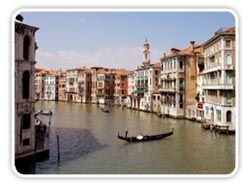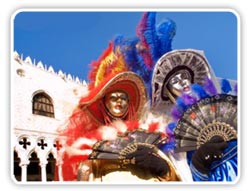
There are times when the magnificent landscape of Venice seems painted. It happens when in a corner, in a minute, the light bounces off this impossible city or goes through the mist or something that must be in the air, and then, there it is: a brush made these strokes with the oil of the gods and decided that His work would have to dazzle humanity forever, but it condemned it at the same time to remain in suspense, terrified at the idea that one day, hopefully never, all this beauty could be submerged in the waters that have since licked the edges of this unique canvas.
How should the traveler enter Venice?
With time, it may be one of the few worthy advice that can be given, because there seems to be no corner of this city that does not deserve to be seen by the visitor. The "Venice experience" is one and many, it is as many as each of the 14 million people who come to it every year, seduced by the well-earned fame of its splendor, want.
Built on a mosaic of more than a hundred islands in the middle of a lagoon fed by the Adriatic, perhaps one can begin to admire the city from its foundations: in reality these "islands", or at least many of them, were not more than mud banks that required enormous effort and the development of great inventiveness to make them suitable for construction.
And who were those who insisted on settling in such a quagmire?
Venice is the first daughter of necessity. Then, of course, it would become the empire of the winged lion and a center of luxury and waste. The inhabitants of the Veneto region (North of Italy) came to these islets, fleeing from the devastation of the Goth warriors who were advancing on their way to Rome. And so, from those mud, the passage of time gave rise to these palaces ...
Travel guides often agree that little has changed about Venice's layout and skyline in the last 500 years. And there are only two ways to get around it: walking and sailing. That is the first question that the newcomer should ask as soon as they get off the train at the Santa Lucía station and receive, at once and without preamble, the shock and the impression of
to be there, on that stage that is part of the collective imagination of much of the world.
When it was only possible to reach it by sea, the columns of San Marcos and San Teodoro marked the entrance to the city (and also the exit of the exiles, so you don't have to walk between them). Divided into six sestieri (districts), San Marco has always been the heart of Venice and there are, standing firm, the columns to one side of what Napoleon once described as "the most elegant room in Europe": San Marcos square.
That is, then, the point that the traveler instinctively looks for in his first time: the goal is the famous piazza - the same one, of course, in the photos with the doves - where he will find the superb basilica in which the remains of the saint rest. -Miraculously saved from the fire of 976 and reappeared in 1904- and the great Ducal Palace. The human river walks in that direction, and it is precisely at this moment that those who are not staying in Venice must answer the question: on foot or by boat? The thing to consider is the following: how do I want to get back to the train station after walking for hours and hours, walking or browsing?
Either option works. You get to San Marcos walking along a hallucinatory route of alleys that suddenly lead to small squares or surprising parks, moving slowly and wonderfully among true architectural gems, among all kinds of merchandise and restaurants hunting for tourists. Or will you
ega for which since the XNUMXth century it has been baptized as “the most beautiful street in the world”.
That it has nothing, it is already known, of street: it is the great canal, which has been the main public thoroughfare of the city since the very foundation of what was the Venetian empire. To circulate along the grand canal there are taxis, expensive gondola rides and perhaps the best option, the vaporetto; which can well be described as the bus that runs through Venice along the almost four kilometers of the canal.
For the first time, the vaporetto is - and it will never really stop being - the best way to appreciate, slowly, the succession of palaces and their best faces: those that overlook the water. This row of palaces built over a period of 500 years were conceived to receive their owners - the ancient aristocracy - who came to them through those same waters that today plow the vaporetti and descended directly into this gallery of Byzantine, Gothic, Renaissance and Baroque that seem to float oblivious to the passage of time.
There is no way to describe or list in this space what Venice has to offer. This is a city that cannot be dispatched by pointing to a monument here and another there, or a must-see museum and a square. All Venice is like a museum. Tod
Venice is a postcard that no photograph, no matter how good, will ever contain. And the first time is a crush: the awakening of the anxiety to try to cover it all, to absorb everything, to know everything about it. To return some day to see the mid-afternoon sun awakening the colors of San Marcos Cathedral from the luxury of a seat in the legendary Florian café or in some modest corner, sharing a Chianti, looking at the dome of the church in the distance from Santa María della Salute and closer, the cruise ships being towed to the sea while the woman you love embraces you and you decide that the first will not be the last time.
To take into account
- It is convenient to take a good guide to appreciate and better understand the places that surprise at every step. The one of Venice and the Veneto of El País-Aguilar is an excellent option and details the main palaces on the route of the grand canal.
- If your budget is tight, a good option to avoid the cost of Venetian hotels is to stay in neighboring Mestre, located a few minutes by train and bus from Venice. Or better yet, a little further on, in beautiful and peaceful Treviso, 25 minutes away by train.
- Taking random streets is great when you have time, but if you only have one day, it is best to plan a tour of the places of greatest interest.
- The Basilica of San Marcos, built between 1063 and 1094 after a fire destroyed the first building that housed the remains of San M arcos, is a must and must-see: from its Greek cross plan to the heights of the so-called Martian Museum where they are (inside) the imposing bronze horses brought as loot from Constantinople in 1204 and their replicas outside with a great view of the piazza.
- Café Florian, under the arcades of San Marcos, is a classic: it was founded on December 29, 1720 and is the oldest café in Italy. It is also possible that it is one of the most expensive in the country where, in addition, the account is charged 5 euros per person if there is live music. Another legend is Harry's Bar, the place where the bellini was invented and a pilgrimage site for gringos who walk in the footsteps of the ghost of Ernest Hemingway, who was a regular at the place. Expensive, pretentious, and no city view.
- In the Cannaregio area, an interesting walk is the ghetto, a peaceful neighborhood where the first Jewish ghetto was established at the beginning of the XNUMXth century. I KNOW



